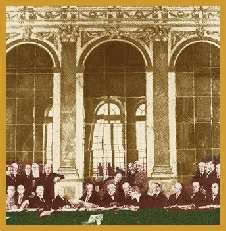|
8. 4 Peace And Diplomacy at the Versailles Conference
The Peace Conference opened at Paris on January
12, 1919. The conference was dominated by the ’Big 4’ namely
Wilson, Lloyd George (Britain), Clemenceau (France) and
Orlando (Italy). The peace treaty included several principles
of the 14 points. It tried to reconcile its agenda with that of
its members’ various secret agreements. However, it was on the whole
a dictated peace move. Germany was made to pay heavy war damages
and her military strength was drastically reduced. Besides, she
was also humiliated for her role in the war.
The treaty with Germany was signed at Versailles in June and was sent to the American Senate for ratification. The Senate rejected it. This was mainly due to the fact that many Senators believed that the provisions for the League of Nations were not in the best interests of the U.S. Moreover, many Republicans were upset that the U.S. peace conference did not have a single Republican leader or Senator.
Though the treaty was not ratified at home, the main achievements of the peace negotiations were the Genesis of the League of Nations and the Provisions for a separate Court of International Justice. These 2 Covenants initiated by President Wilson were to play a significant role in maintaining peace during the next decade at least.

Exhibit 8.2
Treaty of Versailles
[Next Page]
|
Table of Contents
8.0 - Chronology of Major Events
8.1 -
Woodrow Silson's Administration
8.2 -
The U.S. And The First World War
8.3 -
Neutrality Rights
8.4 -
Peace And Diplomacy At The Versailles Conference
8.5 - Points To Remember
Chapter 9
|